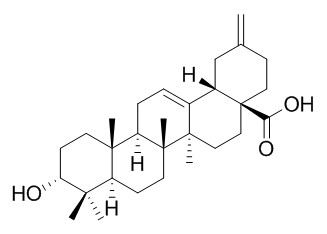3alpha-Akebonoic acid
3α-Akebonoic acid shows interesting in vitro growth inhibitory activity against human tumor A549 and HeLa cell lines, it also shows significant in vitro α-glucosidase inhibitory activity. 3α-Akebonoic acid can interfer with presenilin-1 (PS1)/ β-site APP-cleaving enzyme 1 (BACE1) interaction and reduces Aβ production, the chemical interference of PS1/BACE1 interaction is a promising strategy for Alzheimer’s disease therapeutics.
Inquire / Order:
manager@chemfaces.com
Technical Inquiries:
service@chemfaces.com
Tel:
+86-27-84237783
Fax:
+86-27-84254680
Address:
1 Building, No. 83, CheCheng Rd., Wuhan Economic and Technological Development Zone, Wuhan, Hubei 430056, PRC
Providing storage is as stated on the product vial and the vial is kept tightly sealed, the product can be stored for up to
24 months(2-8C).
Wherever possible, you should prepare and use solutions on the same day. However, if you need to make up stock solutions in advance, we recommend that you store the solution as aliquots in tightly sealed vials at -20C. Generally, these will be useable for up to two weeks. Before use, and prior to opening the vial we recommend that you allow your product to equilibrate to room temperature for at least 1 hour.
Need more advice on solubility, usage and handling? Please email to: service@chemfaces.com
The packaging of the product may have turned upside down during transportation, resulting in the natural compounds adhering to the neck or cap of the vial. take the vial out of its packaging and gently shake to let the compounds fall to the bottom of the vial. for liquid products, centrifuge at 200-500 RPM to gather the liquid at the bottom of the vial. try to avoid loss or contamination during handling.
J Agric Food Chem.2024, 72(45):25219-25228.
Jeju National University Graduate School2023, 24478
Chem Biol Interact.2016, 258:59-68
Bull.Natl.Mus.Nat.Sci.,Ser.B.2024, 50(2):79�C86
Asian J Beauty Cosmetol2016, 14(3):249-257
Fermentation2023, 9(10), 889
Acta Pharm Sin B.2024, 14(4):1772-1786.
Environ Toxicol.2019, 34(4):513-520.
Phytother Res.2015, 29(7):1088-96
Mol Biol Rep.2023, 50(5):4029-4038.
Related and Featured Products
Molecules. 2014 Apr 4;19(4):4301-12
Bioactive 30-noroleanane triterpenes from the pericarps of Akebia trifoliata.[Pubmed:
24714192]
METHODS AND RESULTS:
Two new 30-noroleanane triterpenes, 2α,3β,20α-trihydroxy-30-norolean-12-en-28-oic acid (1), 2α,3β-dihydroxy-23-oxo-30-norolean-12,20(29)-dien-28-oic acid (2), were isolated from the pericarps of Akebia trifoliata, together with four known ones, 3β-akebonoic acid (3), 2α,3β-dihydroxy-30-noroleana-12,20(29)-dien-28-oic acid (4), 3alpha-Akebonoic acid (5) and quinatic acid (6). Their structures were established on the basis of detailed spectroscopic analysis, and they were all isolated from the pericarps of A. trifoliata for the first time. Compounds 3-6 showed in vitro bacteriostatic activity against four assayed Gram-positive bacterial strains. In particular 3 showed antibacterial activity toward MRSA with a MIC value 25 μg/mL, which was more potent than kanamycin (MIC 125 μg/mL). No compounds showed antibacterial activity toward the three Gram-negative bacteria tested.
CONCLUSIONS:
Compounds 4 and 5 showed interesting in vitro growth inhibitory activity against human tumor A549 and HeLa cell lines, with IC50 values ranging from 8.8 and 5.6 μM, respectively. Compounds 1, 2, 5 and 6 were further revealed to show significant in vitro α-glucosidase inhibitory activity with IC50 values from 0.035 to 0.367 mM, which were more potent than the reference compound acarbose (IC50 0.409 mM).
Cell Discov. 2015; 1: 15021.
Targeting the γ-/β-secretase interaction reduces β-amyloid generation and ameliorates Alzheimer’s disease-related pathogenesis[Pubmed:
27462420]
Despite decades of intense global effort, no disease-modifying drugs for Alzheimer’s disease have emerged. Molecules targeting catalytic activities of γ-secretase or β-site APP-cleaving enzyme 1 (BACE1) have been beset by undesired side effects.
METHODS AND RESULTS:
We hypothesized that blocking the interaction between BACE1 and γ-secretase subunit presenilin-1 (PS1) might offer an alternative strategy to selectively suppress Aβ generation. Through high-throughput screening, we discovered that 3alpha-Akebonoic acid (3AA) interferes with PS1/BACE1 interaction and reduces Aβ production. Structural analogs of 3AA were systematically synthesized and the functional analog XYT472B was identified. Photo-activated crosslinking and biochemical competition assays showed that 3AA and XYT472B bind to PS1, interfere with PS1/BACE1 interaction, and reduce Aβ production, whereas sparing secretase activities. Furthermore, treatment of APP/PS1 mice with XYT472B alleviated cognitive dysfunction and Aβ-related pathology.
CONCLUSIONS:
Together, our results indicate that chemical interference of PS1/BACE1 interaction is a promising strategy for Alzheimer’s disease therapeutics.



